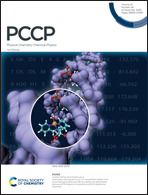Enhanced magnetic anisotropy and Curie temperature of the NiI2 monolayer by applying strain: a first-principles study†
Abstract
Two-dimensional (2D) intrinsic ferromagnetic semiconductors with high magnetic anisotropy (MA) and Curie temperature (TC) are desirable for low-dimensional spintronic applications. We present here the structural stability, MA and TC of the semiconducting NiI2 monolayer under strain from −4% to 4% using first-principles calculations. The unstrained NiI2 monolayer exhibits an in-plane magnetic anisotropy energy of −0.11 meV per unit cell and a TC of 79 K. Most noteworthily, the in-plane MA and TC of the NiI2 monolayer are simultaneously enhanced under compressive strain; meanwhile, the NiI2 monolayer is still stable. In particular, when the compressive strain reaches −4%, the in-plane MA is more than three times higher than that in the unstrained system. Based on the second-order perturbation theory of spin–orbit coupling, the density of states and the orbital magnetic anisotropy contributions are analyzed, indicating that the compressive strain effect originates from the increase of the negative contribution from the spin–orbit coupling interaction between the opposite spin py and px orbitals of the I atom. This study provides a promising route for exploring new 2D ferromagnetic semiconductors with higher MA and TC.



 Please wait while we load your content...
Please wait while we load your content...